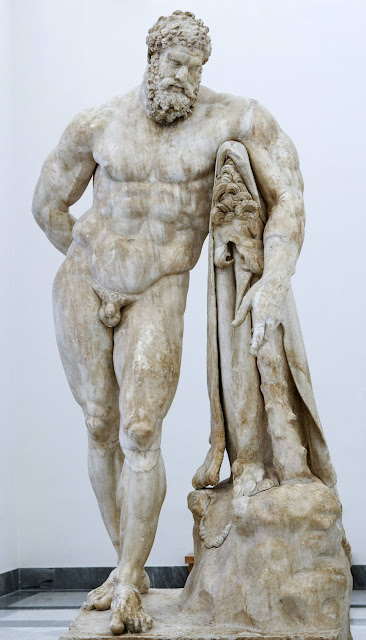 |
| Capitoline Hercules Ancient gilt-bronze statue based on an earlier original Capitoline Museum |
"Perhaps the earliest foreign cult to be received in Rome," in the view of the Oxford Classical Dictionary, was that of Hercules. "His worship at the Ara Maxima had some interesting features. No other god was mentioned; no women were admitted; dogs were excluded. The sacrificial meat had to be eaten or burnt daily; hence the popularity of the sanctuary." Modern scholars are inclined to believe that the large bronze Capitoline Hercules – on display in modern Rome since 1510 – served the city in classical times as a cult statue in a temple. It is one of the few traditionally famous ancient sculptures studied by Haskell and Penny in Taste and the Antique.whose current reputation matches its former reputation.
 |
| after Hendrik Goltzius Capitoline Hercules ca. 1592 engraving British Museum |
 |
| Cornelis Bloemaert Capitoline Hercules 17th century engraving British Museum |
 |
| Farnese Hercules Enlarged Roman marble copy of an earlier Hellenistic statue National Archaeological Museum, Naples |
"The enormous size of the Farnese Hercules made it difficult to see properly – let alone to copy. Bernini insisted that it should be viewed from a distance, while Montesquieu thought that this was true of the front, but that the back should be inspected from close to – indeed, the back was drawn and engraved almost as much as was the front. Obtaining a distant view of the Hercules presents no problem to the visitor to the park at Wilhelmshohe outside Cassel, where on a pyramid-shaped pavilion 63 meters high was placed a copy of the statue 9.20 meters high (nearly three times the size of the original) made by the Augsburg goldsmith Johann Jacob Anthoni between 1713 and 1717. In the seventeenth century plaster casts had been made for Louis XIII and Philip IV, as well as for the French Academies in Rome and Paris. Above all, Le Nôtre placed what seems to have been a full-size copy in the gardens of Vaux-le-Vicomte (now replaced by a gilded lead replica of 1891) as the climax to a suite of gardens and lakes that extended from the chateau, in one of whose rooms Lebrun painted scenes from the life of Hercules, the symbol of Fouquet's power. In 1684-86 Jean Cornu made a marble copy the size of the original for Versailles (where it still remains). In England a full-scale copy by C.H. Smith was carved out of a single block of Portland stone early in the nineteenth century (Geological Museum, London). He was no doubt using the cast which in 1798 had reached the Royal Academy and was causing a controversy as to where it could be installed."
 |
| Jacob Bos and Antoine Lafréry Farnese Hercules 1562 engraving British Museum |
 |
| Pietro da Barga Farnese Hercules ca. .1576 copy - gilt-bronze statuette Metropolitan Museum of Art |
 |
| Giorgio Ghisi Farnese Hercules ca. 1570-80 engraving British Museum |
 |
| Augustinus Terwesten Arm of the Farnese Hercules 1670s etching British Museum |
 |
| Carlo Maratta Farnese Hercules 1670s drawing Royal Collection, Great Briatin |
 |
| Gerard van der Gucht Farnese Hercules illustrating a subscription ticket 1732 etching British Museum |
 |
| Giovanni Pichler Farnese Hercules ca. 1770-90 cameo Metropolitan Museum of Art |
The head of the Emperor Commodus in his portrait statue (engraved below) surmounted a body copied from a much older Greek statue portraying Hercules. His posthumous reputation as one of the evil Emperors is contained in his end – "Commodus, by now obsessively devoted to performing as a gladiator, appeared to be dangerously deranged. Proclaiming a new golden age, he shook off his allegiance to his father's memory, calling himself Lucius Aelius Aurelius Commodus, as well as eight other names, including Hercules Romanus; each month was given one of these names; Rome itself became the Colonia Commodiana. Numerous senators had been executed; others feared the same fate, and Laetus, probably with the connivance of P. Helvius Pertinax and others, had Commodus strangled in the night of 31 December 192."
The engraving below was published about fifty years after the restored ancient marble sculpture of Commodus as Hercules had been installed in one of the niches of honor in the Belvedere Courtyard at the Vatican (neighbor to the Apollo Belvedere and the Laocoön). This statue has also been known as Hercule-Commode ; Hercules and Ajax ; Hercules and Hylas ; Hercules and Telefos.
 |
| Marcello Clodio, publisher Commodus as Hercules ca. 1587-89 engraving British Museum |
 |
| Domenico de Rossi Commodus as Hercules ca. 1704 engraving Philadelphia Museum of Art |
 |
| Hubert Le Sueur Commodus as Hercules 1630s full-size copy in bronze made for Charles I Royal Collection, Great Britain |
 |
| attributed to Adriaen Collaert The Emperor Commodus (as gladiator) killing a leopard ca. 1596 engraving British Museum |